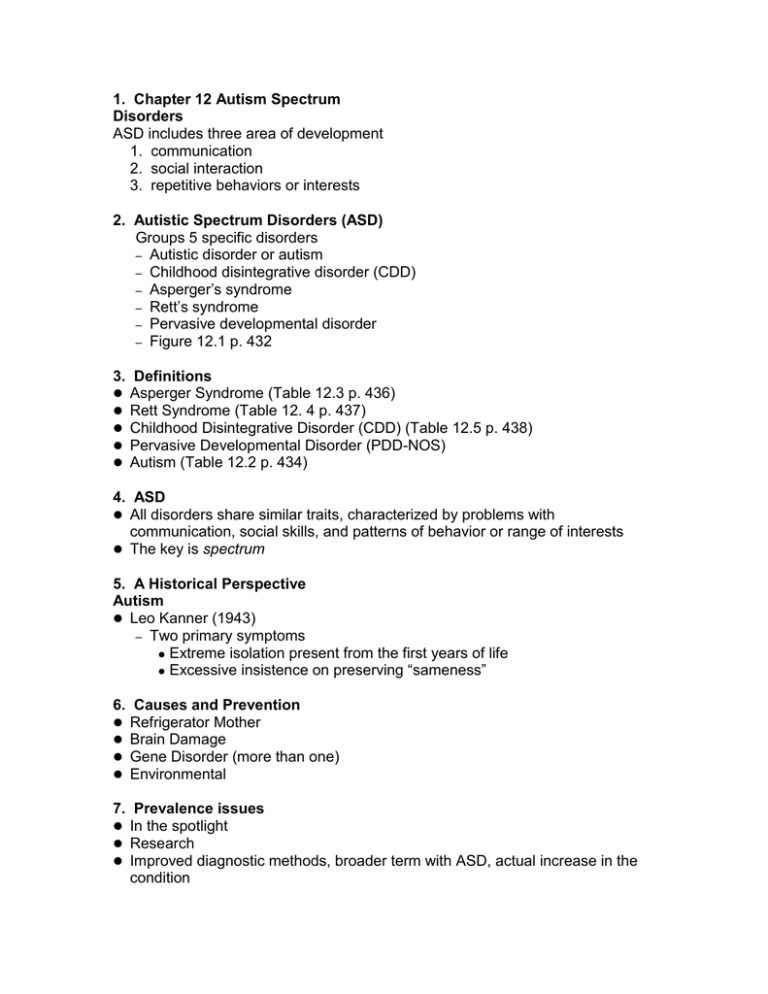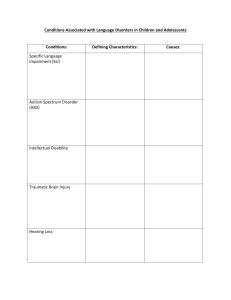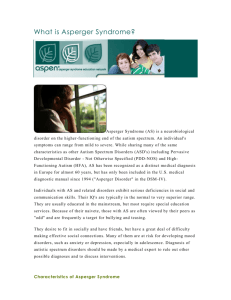1. Chapter 12 Autism Spectrum Disorders 1. communication
advertisement

1. Chapter 12 Autism Spectrum Disorders ASD includes three area of development 1. communication 2. social interaction 3. repetitive behaviors or interests 2. Autistic Spectrum Disorders (ASD) Groups 5 specific disorders – Autistic disorder or autism – Childhood disintegrative disorder (CDD) – Asperger’s syndrome – Rett’s syndrome – Pervasive developmental disorder – Figure 12.1 p. 432 3. Definitions Asperger Syndrome (Table 12.3 p. 436) Rett Syndrome (Table 12. 4 p. 437) Childhood Disintegrative Disorder (CDD) (Table 12.5 p. 438) Pervasive Developmental Disorder (PDD-NOS) Autism (Table 12.2 p. 434) 4. ASD All disorders share similar traits, characterized by problems with communication, social skills, and patterns of behavior or range of interests The key is spectrum 5. A Historical Perspective Autism Leo Kanner (1943) – Two primary symptoms Extreme isolation present from the first years of life Excessive insistence on preserving “sameness” 6. Causes and Prevention Refrigerator Mother Brain Damage Gene Disorder (more than one) Environmental 7. Prevalence issues In the spotlight Research Improved diagnostic methods, broader term with ASD, actual increase in the condition 8. Children with ASD 75% have a concurrent diagnosis of MR 50% never develop functional speech or language 17% engage in high levels of self-injurious behaviors 4 out of 5 are males 33% have epilepsy 9. Assessment We used to only dx a 5 yrs. of age or older, now as young as 3 yrs. of age Autism Diagnostic Observation Scale Screening Test for Autism in Two Year Olds Developmental Assessments Parental interviews 10. Signs or Characteristics of Autism – Impairment in Reciprocal Social Interactions – Poor Communication Abilities – Insistence on Sameness – Unusual Behavior Patterns – Table 12.6 p.439 11. Programs Structured teaching-TEACCH Young Autism Program (YAP)-Lovaas Goal: Developing Functionally Equivalent Behaviors Elements: sufficient structure, supports for functional communication, a functional approach to problem behaviors, supports for social interactions 12. Accommodations Make events predictable Communicate instructions and consequences carefully Foster positive participation 13. Transitions Transition to Preschool Transition Services for Adults Transition Outcomes Table 12.7 p. 451 Collaboration and Partnerships





